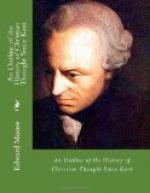[Footnote 3: Paulsen, Kant, a. 2.]
On the other hand, with the idealists, Kant is fully persuaded that there is a meaning in things and that we can know it. There is a sense in life. With immediate certainty we set moral good as the absolute aim in life. This is done, however, not through the pure reason or by scientific thinking, but primarily through the will, or as Kant prefers to call it, the practical reason. What is meant by the practical reason is the intelligence, the will and the affections operating together; that is to say, the whole man and not merely his intellect, directed to those problems upon which, in sympathy and moral reaction, the whole man must be directed and upon which the pure reason, the mere faculty of ratiocination, does not adequately operate. In the practical reason the will is the central thing. The will is that faculty of man to which moral magnitudes appeal. It is with moral magnitudes that the will is primarily concerned. The pure reason may operate without the will and the affections. The will, as a source of knowledge, never works without the intelligence and the affections. But it is the will which alone judges according to the predicates good and evil. The pure reason judges according to the predicates true and false. It is the practical reason which ventures the credence that moral worth is the supreme worth in life. It then confirms this ventured credence in a manifold experience that yields a certainty with which no certainty of objects given in the senses is for a moment to be compared. We know that which we have believed. We know it as well as that two and two make four. Still we do not know it in the same way. Nor can we bring knowledge of it to others save through an act of freedom on their part, which is parallel to the original act of freedom on our own part.
How can these two modes of thought stand related the one to the other? Kant’s answer is that they correspond to the distinction between two worlds, the world of sense and the transcendental or supersensible world. The pure and the practical reason are the faculties of man for dealing with these two worlds respectively, the phenomenal and the noumenal. The world which is the object of scientific investigation is not the actuality itself. This is true in spite of the fact that to the common man the material and sensible is always, as he would say, the real. On the contrary, in Kant’s opinion the material world is only the presentation to our senses of something deeper, of which our senses are no judge. The reality lies behind this sensible presentation and appearance. The world of religious belief is the world of this transcendent reality. The spirit of man, which is not pure reason only, but moral will as well, recognises itself also as part of this reality. It expresses the essence of that mysterious reality in terms of its own essence. Its own essence as free spirit is the highest aspect of reality of which it is aware. It may be unconscious of the symbolic nature of its language in describing that which is higher than anything which we know, by the highest which we do know. Yet, granting that, and supposing that it is not a contradiction to attempt a description of the transcendent at all, there is no description which carries us so far.




